Tailoring Multiple Strengthening Phases to Achieve Superior High-Temperature Strength in Cast Mg-RE-Ag Alloys
Abstract
1. Introduction
2. Materials and Methods
3. Results and Discussion
3.1. Microstructures
3.2. Mechanical Properties
3.2.1. Hardness
3.2.2. Tensile Properties
3.3. Fracture Morphologies
4. Conclusions
Author Contributions
Funding
Institutional Review Board Statement
Informed Consent Statement
Data Availability Statement
Conflicts of Interest
References
- Manchón-Gordón, A.F.; Sánchez-Jiménez, P.E.; Blázquez, J.S.; Perejón, A.; Pérez-Maqueda, L.A. Structural, vibrational, and magnetic characterization of orthoferrite LaFeO3 ceramic prepared by reaction Fflash sintering. Materials 2023, 16, 1019. [Google Scholar] [CrossRef] [PubMed]
- Miracle, D.B.; Senkov, O.N. A critical review of high entropy alloys and related concepts. Acta. Mater. 2017, 122, 448–511. [Google Scholar] [CrossRef]
- Diniță, A.; Neacșa, A.; Portoacă, A.I.; Tănase, M.; Ilinca, C.N.; Ramadan, I.N. Additive manufacturing post-processing treatments, a review with emphasis on mechanical characteristics. Materials 2023, 16, 4610. [Google Scholar] [CrossRef] [PubMed]
- Zhu, W.; Zhang, J.; Wei, Z.; Zhang, B.; Weng, X. Advances and progress in self-healing hydrogel and its application in regenerative medicine. Materials 2023, 16, 1215. [Google Scholar] [CrossRef] [PubMed]
- Ferraz, M.P. Bone grafts in dental medicine: An overview of autografts, allografts and synthetic materials. Materials 2023, 16, 4117. [Google Scholar] [CrossRef]
- Ma, T.; Zhao, S.C.; Guo, E.; Zhao, L.L.; Fan, R.; Zhang, Y.; Wang, L.P. Microstructure evolution and strengthening mechanism analysis of novel Mg-RE-Ag alloy during heat treatment. J. Mater. Res. Technol. 2022, 21, 692–703. [Google Scholar] [CrossRef]
- Meier, J.M.; Caris, J.; Luo, A.A. Towards high strength cast Mg-RE based alloys, phase diagrams and strengthening mechanisms. J. Magnes. Alloy. 2022, 10, 1401–1427. [Google Scholar] [CrossRef]
- Nazeer, F.; Long, J.Y.; Yang, Z.; Li, C. Superplastic deformation behavior of Mg alloys, A-review. J. Magnes. Alloy. 2022, 10, 97–109. [Google Scholar] [CrossRef]
- Arhin, G.; Ma, A.B.; Jiang, J.H.; Taylor, E.K.; Song, D. Microstructure evolution and mechanical properties of Mg-Mn-RE alloy processed by equal channel angular pressing. Mater. Today Commun. 2024, 38, 107744. [Google Scholar] [CrossRef]
- Ma, T.; Zhao, S.C.; Guo, E.; Zhao, L.L.; Fan, R.; Zhang, Y.; Wang, L.P. Formation of enclosed precipitates structure in a novel Mg-RE alloy to enhance high-temperature mechanical properties. Mater. Lett. 2022, 327, 133048. [Google Scholar] [CrossRef]
- Drozdenko, D.; Fekete, K.; Dobron, P.; Németh, G.; Vesely, J.; Nishimoto, S.; Yamasaki, M.; Kawamura, Y. The microstructure and anisotropic deformation behavior of rapidly solidified ribbon consolidated Mg-Zn-X (X = Y, Gd, Nd) alloys. J. Alloys Compd. 2023, 944, 169175. [Google Scholar] [CrossRef]
- Zhao, S.S.; Xu, Y.J.; Geng, C.G.; Lin, X.P.; Tang, Q.; Dong, Y. High temperature mechanical properties and strain hardening mechanism of directionally solidified Mg-Gd-Y alloy. Mater. Sci. Eng. A 2022, 833, 142337. [Google Scholar] [CrossRef]
- Greeley, D.A.; Adams, J.F.; Kenesei, P.; Spear, A.D.; Allison, J.E. Quantitative analysis of three-dimensional fatigue crack path selection in Mg alloy WE43 using high-energy X-ray diffraction microscopy. Fatigue Fract. Eng. Mater. Struct. 2024; ahead-of-print. [Google Scholar] [CrossRef]
- Zeng, Y.; Sun, K.X.; Qian, X.Y.; Davis, A.; Yuan, Y.; Jiang, B.; Huang, Y.D.; Yin, D.D. Achieving advanced elevated-temperature strength by tailoring precipitates in Mg-Sn-Y alloys. J. Alloys Compd. 2022, 924, 166644. [Google Scholar] [CrossRef]
- Dai, J.W.; Dong, Q.S.; Nie, Y.J.; Jia, Y.Q.; Chu, C.L.; Zhang, X.B. Insight into the role of Y addition in the microstructures, mechanical and corrosion properties of as-cast Mg-Gd-Y-Zn-Ca-Zr alloys. Mater. Des. 2022, 221, 110980. [Google Scholar] [CrossRef]
- Wang, Y.J.; Jiang, H.T.; Liu, C.M.; Zhang, Y.; Guo, W.Q.; Kang, Q.; Xu, Z.; Wang, P.P. Effect of Ca-addition on Hot Deformation Behavior and Workability of Mg-Gd-Y-Zn-Zr Alloy. Rare Metal. Mater. Eng. 2020, 49, 1650–1656. [Google Scholar]
- Zeng, H.H.; Bian, L.P.; Zhao, Y.L.; Yang, F.; Wan, Q.; Liang, W.; Zhao, X.G. Influence of Ca and Al on LPSO phase in Mg-Gd-Zn alloys and their mechanical properties. Rare Metal. Mater. Eng. 2019, 48, 1996–2001. [Google Scholar]
- Xu, C.; Nakata, T.; Oh-ishi, K.; Homma, T.; Ozaki, T.; Kamado, S. Improving creep property of Mg-Gd-Zn alloy via trace Ca addition. Scr. Mater. 2017, 139, 34–38. [Google Scholar] [CrossRef]
- Rezaei, A.; Mahmudi, R.; Logé, R.E. Microstructural and hardness homogeneity in an Mg-Gd-Y-Ag alloy processed by simple shear extrusion. Mater. Sci. Eng. A 2023, 876, 145159. [Google Scholar] [CrossRef]
- Liao, H.T.; Kimizuka, H.; Ishii, A.; Du, J.P.; Ogata, S. Nucleation kinetics of the beta precipitate in dilute Mg-Y alloys, A kinetic Monte Carlo study. Scr. Mater. 2022, 210, 114480. [Google Scholar] [CrossRef]
- Solomon, E.L.S.; Natarajan, A.R.; Roy, A.M.; Sundararaghavan, V.; Van der Ven, A.; Marquis, E.A. Stability and strain-driven evolution of beta precipitate in Mg-Y alloys. Acta. Mater. 2019, 166, 148–157. [Google Scholar] [CrossRef]
- Alizadeh, R.; Wang, J.Y.; Llorca, J. Precipitate strengthening of pyramidal slip in Mg-Zn alloys. Mater. Sci. Eng. A 2021, 804, 140697. [Google Scholar] [CrossRef]
- Du, Y.Z.; Jiang, B.L.; Ge, Y.F. Effects of precipitates on microstructure evolution and texture in Mg-Zn alloy during hot deformation. Vacuum 2018, 148, 27–32. [Google Scholar] [CrossRef]
- Kim, B.H.; Park, K.C.; Park, Y.H.; Park, I.M. Effect of Ca and Sr additions on high temperature and corrosion properties of Mg-4Al-2Sn based alloys. Mater. Sci. Eng. A 2011, 528, 808–814. [Google Scholar] [CrossRef]
- Zha, M.; Wang, S.C.; Jia, H.L.; Yang, Y.; Ma, P.K.; Wang, H.Y. Effect of minor Ca addition on microstructure and mechanical properties of a low-alloyed Mg-Al-Zn-Sn alloy. Mater. Sci. Eng. A 2023, 862, 144457. [Google Scholar] [CrossRef]
- Nagasivamuni, B.; Wang, G.; StJohn, D.H.; Dargusch, M.S. Effect of ultrasonic treatment on the alloying and grain refinement efficiency of a Mg—Zr master alloy added to magnesium at hypo- and hyper-peritectic compositions. J. Cryst. Growth 2019, 512, 20–32. [Google Scholar] [CrossRef]
- Li, S.B.; Du, W.B.; Wang, X.D.; Liu, K.; Wang, Z.H. Effect of Zr addition on the grain refinement mechanism of Mg-Gd-Er Alloys. Acta Metall. Sin. 2018, 54, 911–917. [Google Scholar] [CrossRef]
- Rezaei, A.; Mahmudi, R.; Logé, R.E. Superplastic behavior of a fine-grained Mg-Gd-Y-Ag alloy processed by equal channel angular pressing. J. Magnes. Alloy 2023, 11, 3815–3828. [Google Scholar] [CrossRef]
- Liao, J.E.; Song, J.F.; Chen, G.; Zhao, H.; Tong, S.K.; Zhou, J.; Jiang, B.; Xu, J.Y.; Pan, F.S. Effect of minor Ag and Ce additions on hot tearing susceptibility of Mg-10Gd-3Y-0.5Zr alloy. Int. J. Metalcast. 2023, 17, 2689–2701. [Google Scholar] [CrossRef]
- Zhang, D.H.; Zhao, S.C.; Wang, C.L.; Liu, D.R.; Feng, Y.C.; Wang, L.; Wang, L.P.; Li, J.F.; Wang, Z.W. Achieving enhanced high-temperature mechanical properties in Mg-Nd-Sm-Zn-Ca-Zr alloy by Ag addition. Mater. Today Commun. 2022, 31, 103666. [Google Scholar] [CrossRef]
- Ali, Y.H.; Qiu, D.; Jiang, B.; Pan, F.S.; Zhang, M.X. Current research progress in grain refinement of cast magnesium alloys, A review article. J. Alloys Compd. 2015, 619, 639–651. [Google Scholar] [CrossRef]
- Gao, X.; He, S.M.; Zeng, X.Q.; Peng, L.M.; Ding, W.J.; Nie, J.F. Microstructure evolution in a Mg-15Gd-0.5Zr wt.%, alloy during isothermal aging at 250 degrees C. Mater. Sci. Eng. A 2006, 431, 322–327. [Google Scholar] [CrossRef]
- Han, W.Y.; Yang, G.Y.; Xiao, L.; Li, J.H.; Jie, W.Q. Creep properties and creep microstructure evolution of Mg-2.49Nd-1.82Gd-0.19Zn-0.4Zr alloy. Mater. Sci. Eng. A 2017, 684, 90–100. [Google Scholar] [CrossRef]
- Zhao, S.C.; Guo, E.J.; Cao, G.J.; Wang, L.P.; Lun, Y.C.; Feng, Y.C. Microstructure and mechanical properties of Mg-Nd-Zn-Zr alloy processed by integrated extrusion and equal channel angular pressing. J. Alloys Compd. 2017, 705, 118–125. [Google Scholar] [CrossRef]
- Fu, Y.K.; Wang, L.P.; Feng, Y.C.; Wang, L. Effect of Gd/Y on microstructure evolution and mechanical properties of as-cast Mg-13(Gd, Y)-1Zn-1Al alloys. J. Mater. Eng. Perform. 2023, 32, 4005–4013. [Google Scholar] [CrossRef]
- Peng, X.; Shi, H.X.; Ding, D.H.; Liao, G.L.; Wu, G.H.; Liu, W.C.; Ding, W.J. Microstructural evolution, mechanical properties and corrosion behavior of as-cast Mg-5Li-3Al-2Zn alloy with different Sn and Y addition. J. Mater. Sci. Technol. 2021, 72, 16–22. [Google Scholar] [CrossRef]
- Zhao, R.; Zhu, W.; Zhang, J.S.; Zhang, L.L.; Zhang, J.X.; Xu, C.X. Influence of Ni and Bi microalloying on microstructure and mechanical properties of as-cast low RE LPSO-containing Mg-Zn-Y-Mn alloy. Mater. Sci. Eng. A 2020, 788, 139594. [Google Scholar] [CrossRef]
- Wu, X.F.; Xu, C.X.; Zhang, Z.W.; Yang, W.F.; Zhang, J.S.; Zhang, W.X. Effect of Y-element on microstructure and mechanical properties of as-cast Mg-3Zn-1Mn alloy containing I and W phase. Adv. Eng. Mater. 2020, 22, 1900964. [Google Scholar] [CrossRef]
- Zhang, S.; Song, J.F.; Liao, H.X.; Liu, Y.L.; Zhang, G.; Ma, S.D.; Tang, A.T.; Atrens, A.; Pan, F.S. Effect of boron on the grain refinement and mechanical properties of as-cast Mg alloy AM50. Materials 2019, 12, 12071100. [Google Scholar] [CrossRef] [PubMed]
- Fu, Y.; Wang, H.; Zhang, C.; Hao, H. Effects of minor Sr additions on the as-cast microstructure, fluidity and mechanical properties of Mg-4.2Zn-1.7RE-0.8Zr-0.2Ca wt%, alloy. Mater. Sci. Eng. A 2018, 723, 118–125. [Google Scholar] [CrossRef]
- Liu, F.; Xie, H.J.; Li, Y. Partial Substitution of Gd with Y on the lattice parameter, microstructure, and mechanical properties of the as-cast Mg-4Gd-2Zn alloy. J. Mater. Eng. Perform. 2023, 32, 3542–3549. [Google Scholar] [CrossRef]
- You, S.H.; Huang, Y.D.; Dieringa, H.; Maawad, E.; Gan, W.M.; Zhang, Y.P.; Kainer, K.U.; Willumeit-Romer, R.; Hort, N. Effects of Y additions on the microstructures and mechanical behaviours of as cast Mg-xY-0.5Zr alloys. Adv. Eng. Mater. 2022, 24, 2101033. [Google Scholar] [CrossRef]
- Liu, Z.H.; Wang, L.; Wang, L.P.; Feng, Y.C.; Kang, F.W.; Wang, B.; Li, S.Z.; Hu, C.S. Effect of Al addition on the grain refinement and mechanical properties of as-cast Mg-5Y-4Sm alloys. J. Mater. Sci. 2022, 57, 15137–15150. [Google Scholar] [CrossRef]
- Hong, L.X.; Wang, R.X.; Zhang, X.B. Effects of Nd on microstructure and mechanical properties of as-cast Mg-12Gd-2Zn-xNd-0.4Zr alloys with stacking faults. Int. J. Miner. Metall. Mater. 2022, 29, 1570–1577. [Google Scholar] [CrossRef]
- Rong, W.; Wu, Y.J.; Zhang, Y.; Sun, M.; Chen, J.; Peng, L.M.; Ding, W.J. Characterization and strengthening effects of gamma precipitates in a high-strength casting Mg-15Gd-1Zn-0.4Zr (wt.%) alloy. Mater. Charact. 2017, 126, 1–9. [Google Scholar] [CrossRef]
- Zhang, C.S.; Zhao, S.C.; Li, J.F.; Feng, Y.C.; Wang, L.; Wang, Z.W.; Guo, E.J. Precipitation behavior and mechanical properties of Mg-Nd-Sm-Zn-Zr alloy. J. Mater. Res. Technol. 2024, 28, 3385–3395. [Google Scholar] [CrossRef]
- Liu, K.; Zhao, S.C.; Wang, Z.W.; Feng, Y.C.; Wang, C.L.; Wang, L.; Liu, D.R.; Li, J.F. Effect of Nd on the microstructure and mechanical properties of hot extruded Mg-2.0Sm-0.4Zn-0.4Zr Alloy. J. Mater. Eng. Perform. 2022, 31, 4369–4374. [Google Scholar] [CrossRef]
- Mohamed, O.O.; Azzeddine, H.; Huang, Y.; Baudin, T.; Bazarnik, P.; Brisset, F.; Kawasaki, M.; Langdon, T.G. Investigation of microstructure and texture evolution in an AZ31/Mg-Gd alloy hybrid metal fabricated by high-pressure torsion. Adv. Eng. Mater. 2023, 25, 2201794. [Google Scholar] [CrossRef]
- Takagi, K.; Yamasaki, M.; Mine, Y.; Takashima, K. Temperature dependence of prismatic slip in a single-crystalline long-period stacking ordered Mg-Zn-Y alloy. Scr. Mater. 2020, 178, 498–502. [Google Scholar] [CrossRef]
- Lukyanova, E.; Martynenko, N.; Rybalchenko, O.; Dobatkina, T.; Tarytina, I.; Tabachkova, N.; Rybalchenko, G.; Andreeva, N.; Dobatkin, S. Effect of Samarium on the properties of hot-extruded Mg-Y-Gd-Zr alloys. Crystals 2023, 13, 1443. [Google Scholar] [CrossRef]
- Mohamed, O.O.; Bazarnik, P.; Huang, Y.; Azzeddine, H.; Baudin, T.; Brisset, F.; Langdon, T.G. A comparative study between AZ31 and Mg-Gd alloys after high-pressure torsion. J. Mater. Eng. Perform. 2023; ahead-of-print. [Google Scholar] [CrossRef]

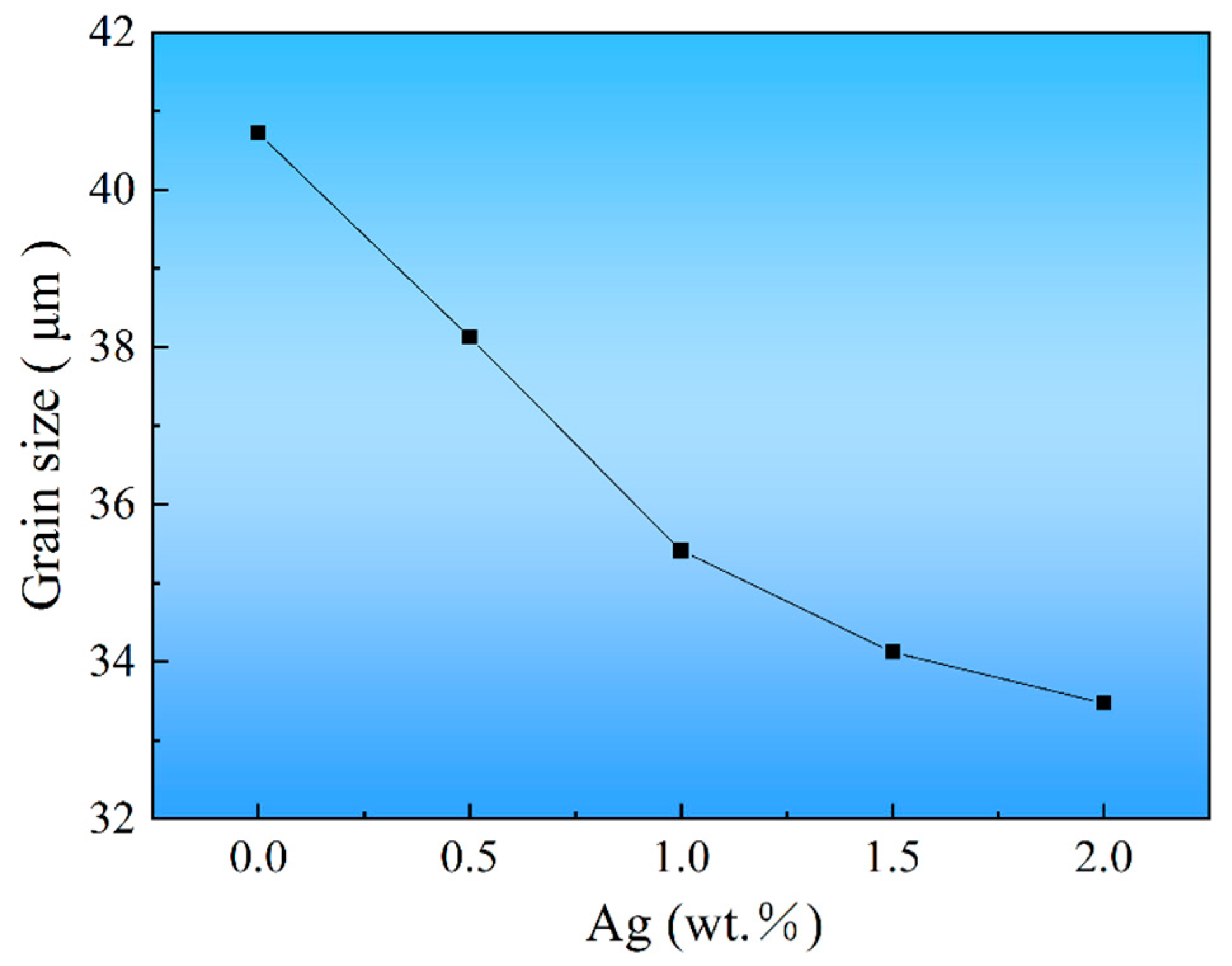


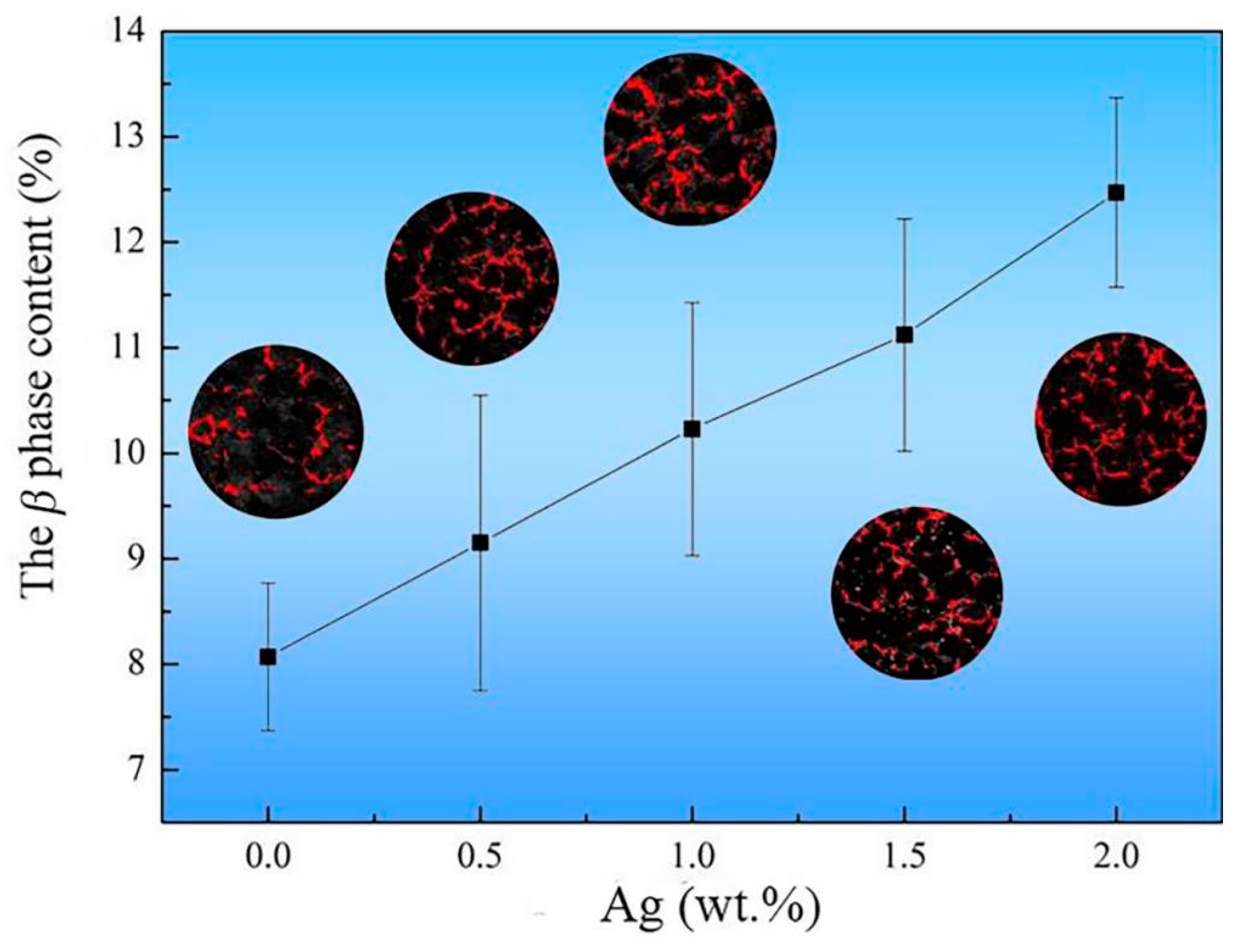
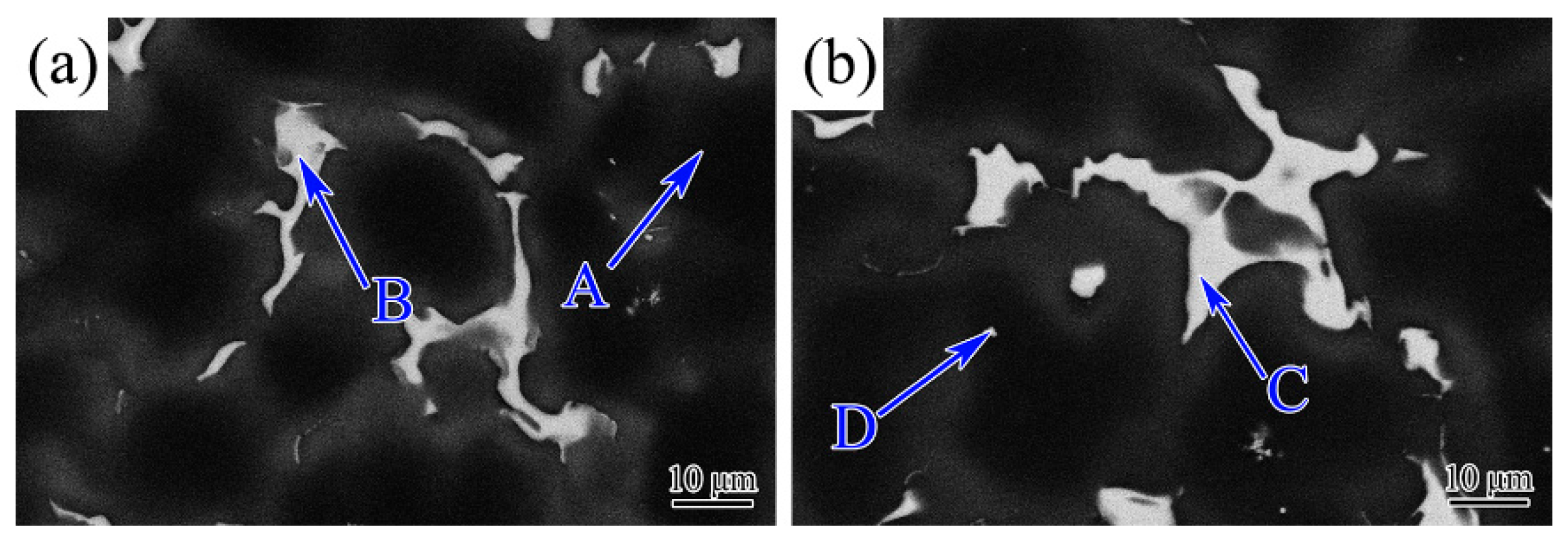
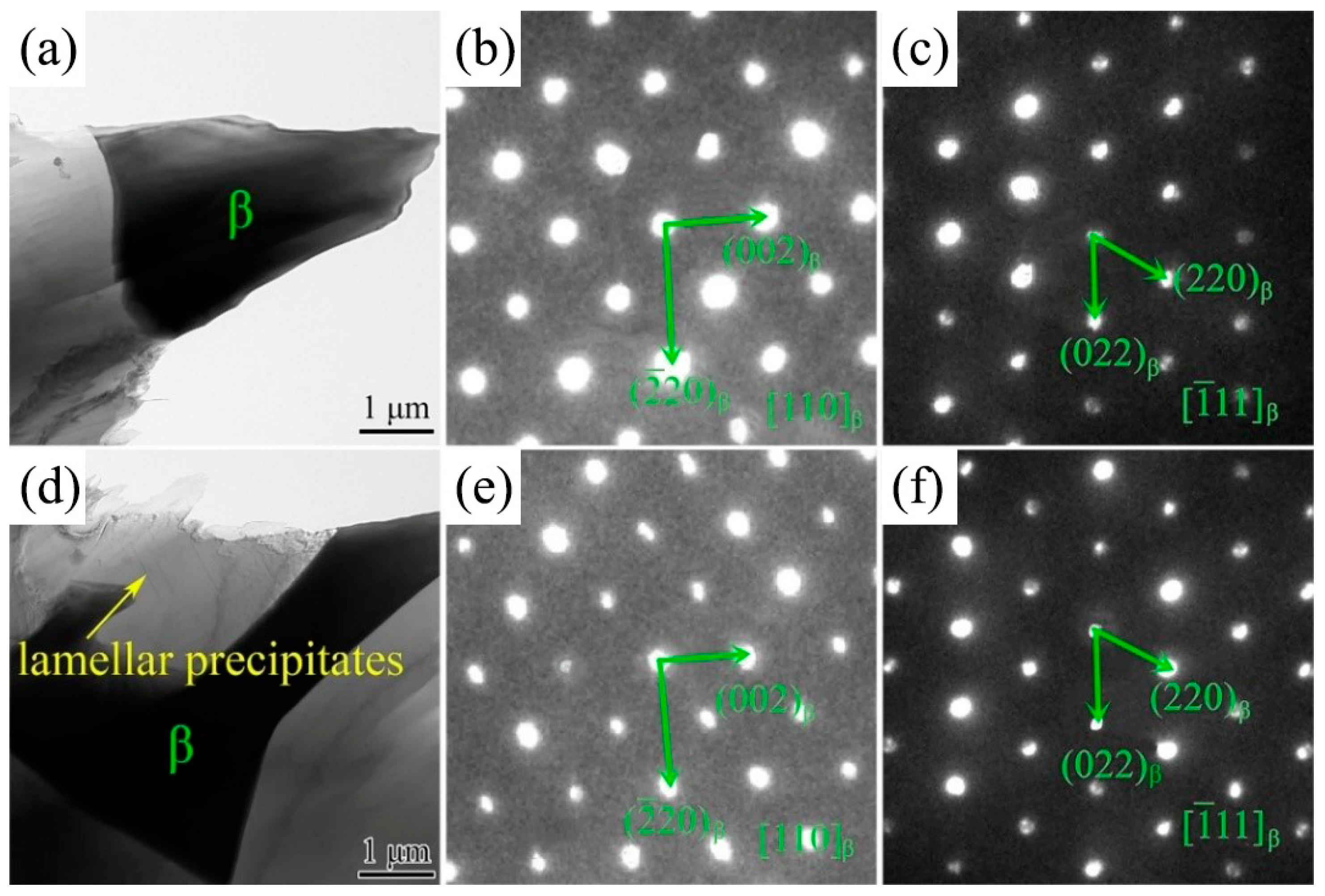
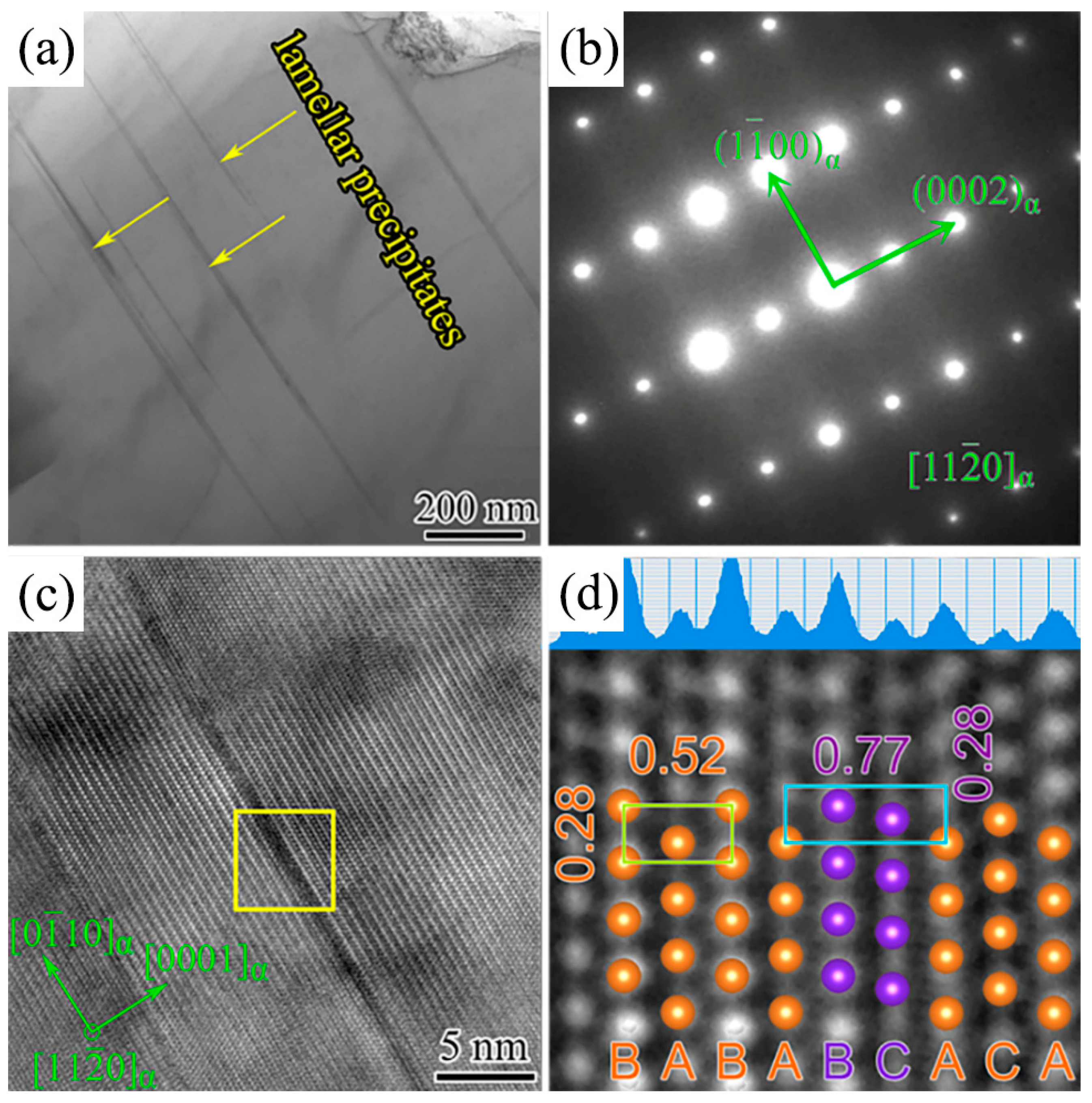
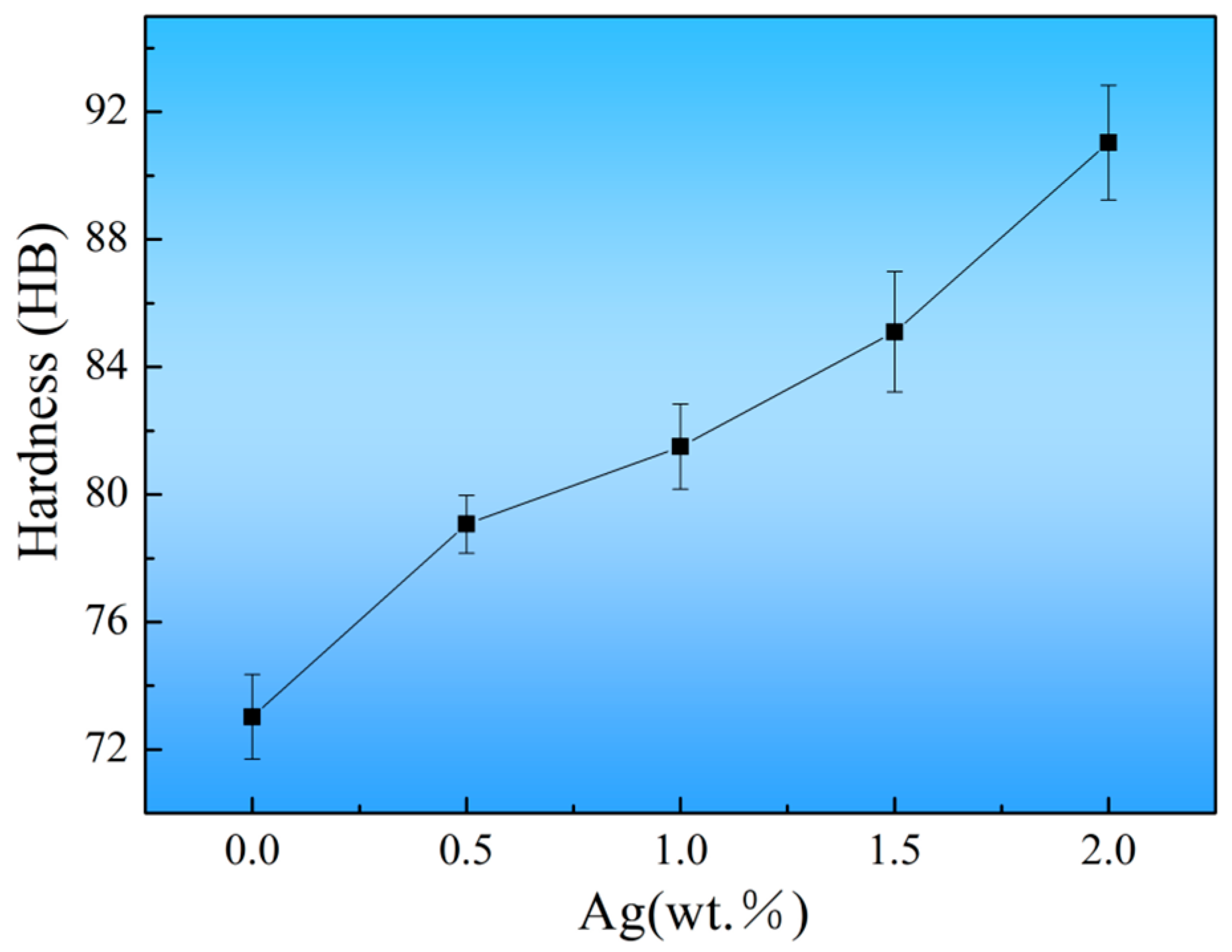
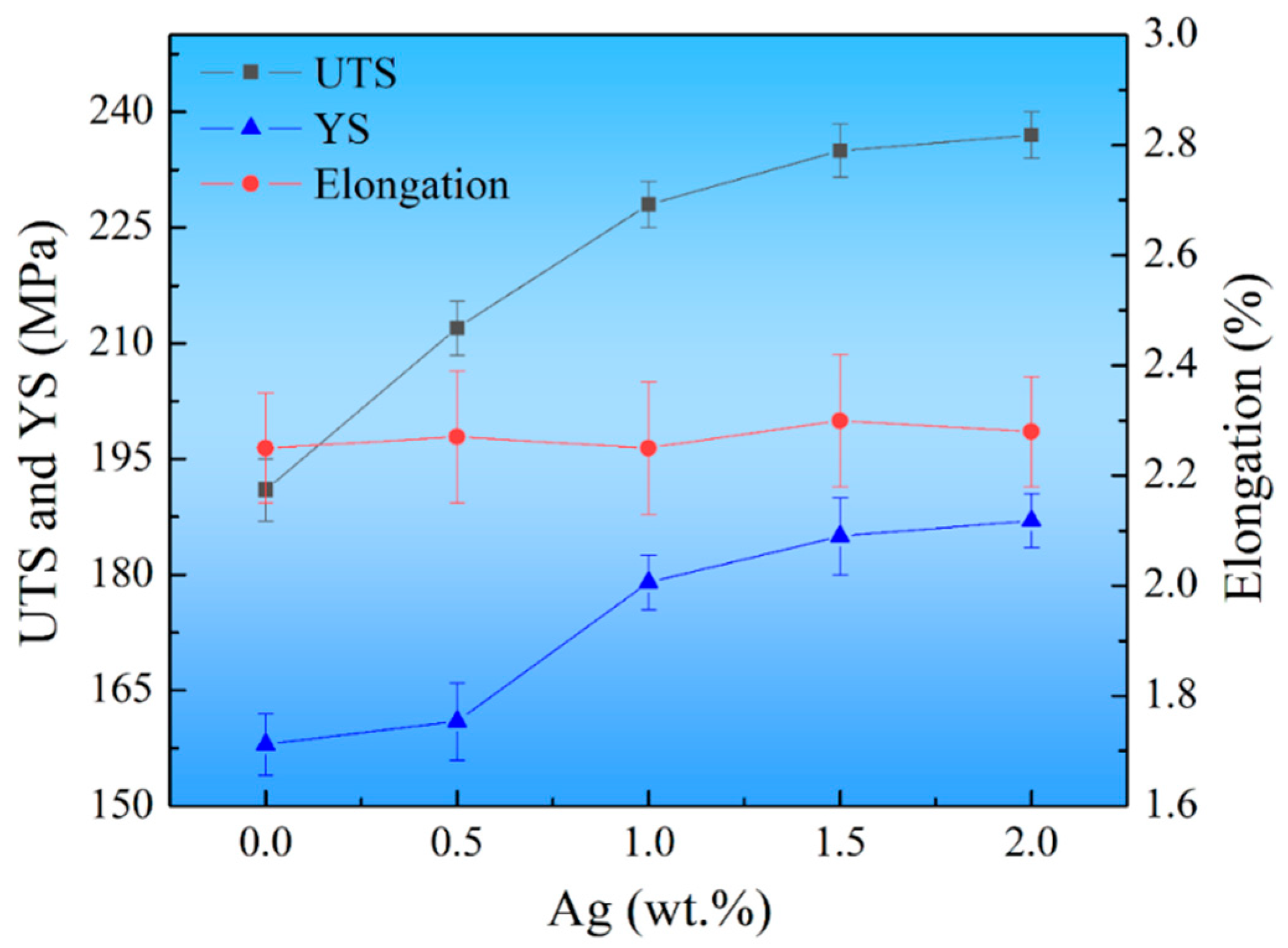
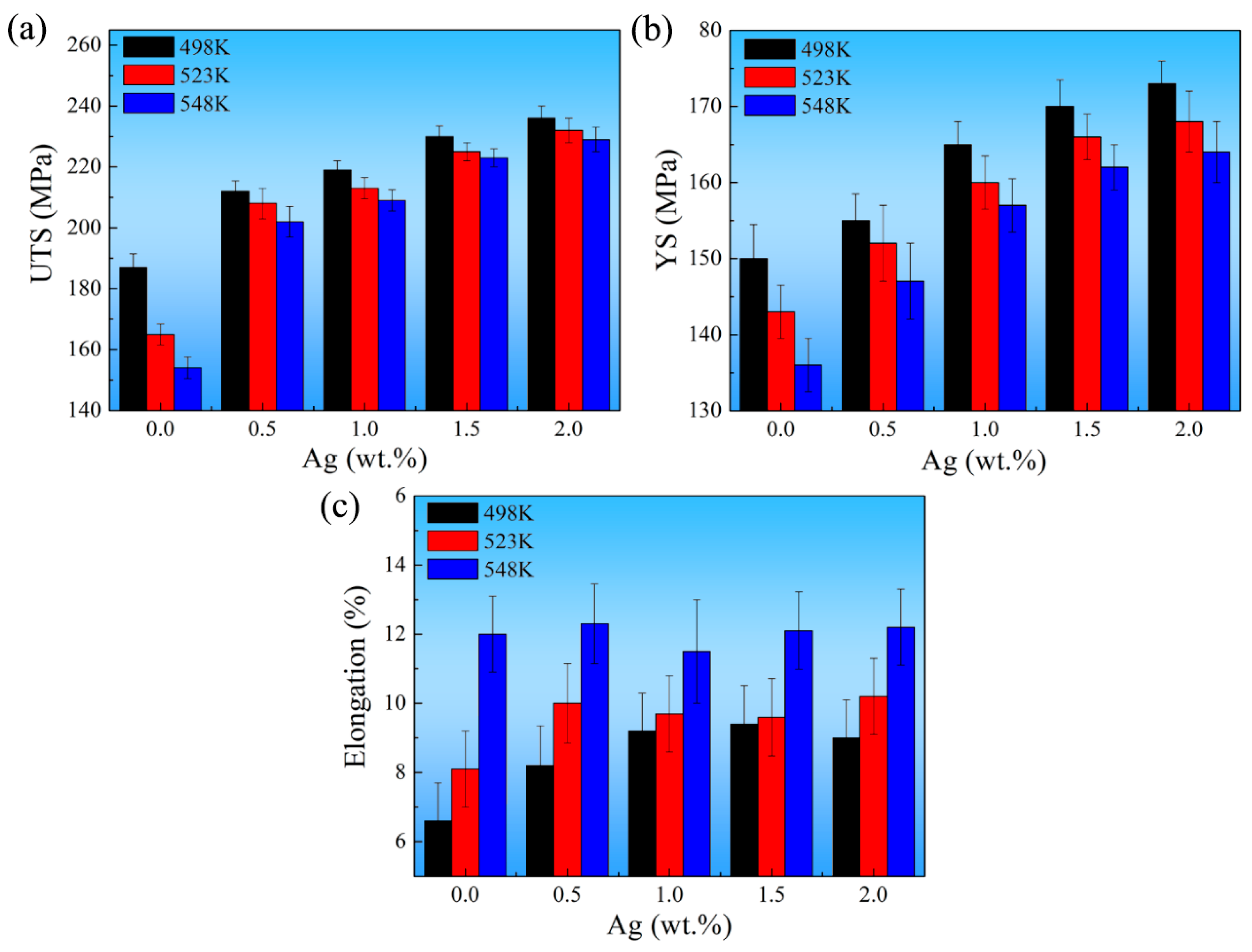
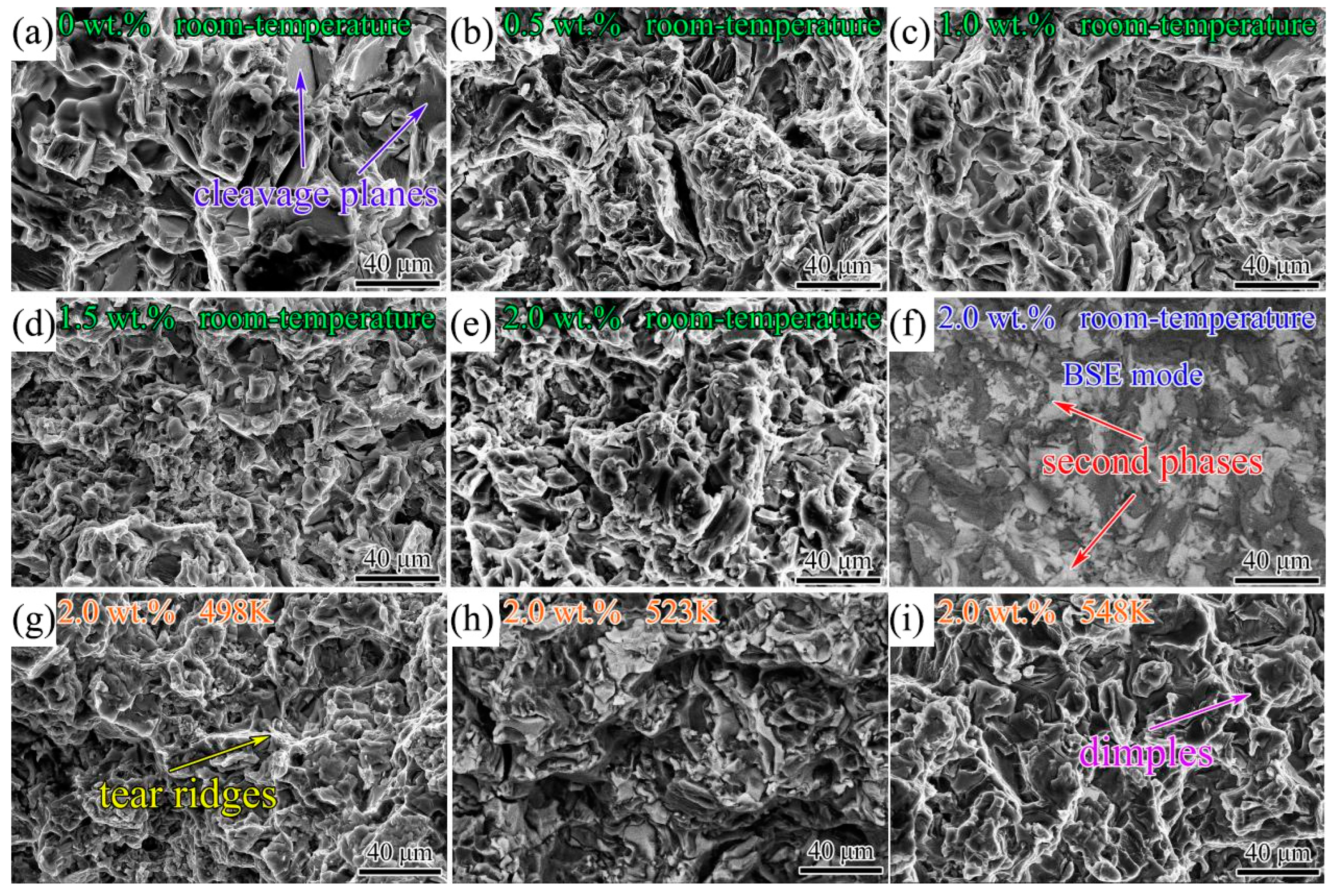
| Alloy | Ag | Gd | Y | Zn | Zr | Ca | Mg | ||||||
|---|---|---|---|---|---|---|---|---|---|---|---|---|---|
| wt.% | at.% | wt.% | at.% | wt.% | at.% | wt.% | at.% | wt.% | at.% | wt.% | at.% | — | |
| 0 Ag | — | — | 9.89 | 1.70 | 1.59 | 0.48 | 0.41 | 0.17 | 0.51 | 0.15 | 0.15 | 0.10 | Bal. |
| 0.5 Ag | 0.52 | 0.13 | 10.05 | 1.74 | 1.61 | 0.49 | 0.39 | 0.16 | 0.52 | 0.16 | 0.16 | 0.11 | Bal. |
| 1.0 Ag | 1.04 | 0.26 | 9.88 | 1.72 | 1.56 | 0.48 | 0.40 | 0.17 | 0.51 | 0.15 | 0.15 | 0.10 | Bal. |
| 1.5 Ag | 1.50 | 0.38 | 10.11 | 1.77 | 1.60 | 0.49 | 0.41 | 0.17 | 0.50 | 0.15 | 0.15 | 0.10 | Bal. |
| 2.0 Ag | 2.05 | 0.53 | 10.25 | 1.80 | 1.59 | 0.49 | 0.41 | 0.17 | 0.51 | 0.15 | 0.16 | 0.11 | Bal. |
| Point | Mg | Ag | Gd | Y | Zr | Zn | Ca | |||||||
|---|---|---|---|---|---|---|---|---|---|---|---|---|---|---|
| at.% | wt.% | at.% | wt.% | at.% | wt.% | at.% | wt.% | at.% | wt.% | at.% | wt.% | at.% | wt.% | |
| A | 97.67 | 88.44 | — | — | 1.62 | 9.49 | 0.37 | 1.23 | 0.12 | 0.41 | 0.11 | 0.27 | 0.11 | 0.16 |
| B | 84.31 | 50.11 | — | — | 10.78 | 41.46 | 1.95 | 4.24 | — | — | 2.08 | 3.33 | 0.88 | 0.86 |
| C | 83.65 | 49.35 | 2.41 | 6.31 | 9.39 | 35.84 | 2.44 | 5.27 | 0.16 | 0.35 | 1.61 | 2.56 | 0.34 | 0.33 |
| D | 83.91 | 57.60 | 0.24 | 0.73 | 0.52 | 2.31 | — | — | 15.20 | 39.16 | 0.08 | 0.15 | 0.05 | 0.06 |
Disclaimer/Publisher’s Note: The statements, opinions and data contained in all publications are solely those of the individual author(s) and contributor(s) and not of MDPI and/or the editor(s). MDPI and/or the editor(s) disclaim responsibility for any injury to people or property resulting from any ideas, methods, instructions or products referred to in the content. |
© 2024 by the authors. Licensee MDPI, Basel, Switzerland. This article is an open access article distributed under the terms and conditions of the Creative Commons Attribution (CC BY) license (https://creativecommons.org/licenses/by/4.0/).
Share and Cite
Zhao, S.; Guo, E.; Liu, K.; Li, J.; Liu, J.; Li, M. Tailoring Multiple Strengthening Phases to Achieve Superior High-Temperature Strength in Cast Mg-RE-Ag Alloys. Materials 2024, 17, 901. https://doi.org/10.3390/ma17040901
Zhao S, Guo E, Liu K, Li J, Liu J, Li M. Tailoring Multiple Strengthening Phases to Achieve Superior High-Temperature Strength in Cast Mg-RE-Ag Alloys. Materials. 2024; 17(4):901. https://doi.org/10.3390/ma17040901
Chicago/Turabian StyleZhao, Sicong, Erjun Guo, Kun Liu, Jingfang Li, Jianhua Liu, and Mingyang Li. 2024. "Tailoring Multiple Strengthening Phases to Achieve Superior High-Temperature Strength in Cast Mg-RE-Ag Alloys" Materials 17, no. 4: 901. https://doi.org/10.3390/ma17040901
APA StyleZhao, S., Guo, E., Liu, K., Li, J., Liu, J., & Li, M. (2024). Tailoring Multiple Strengthening Phases to Achieve Superior High-Temperature Strength in Cast Mg-RE-Ag Alloys. Materials, 17(4), 901. https://doi.org/10.3390/ma17040901





